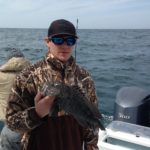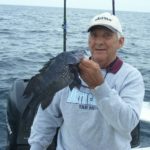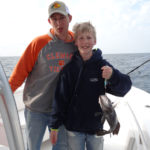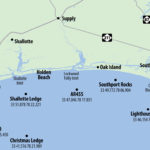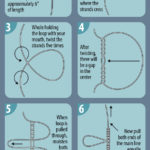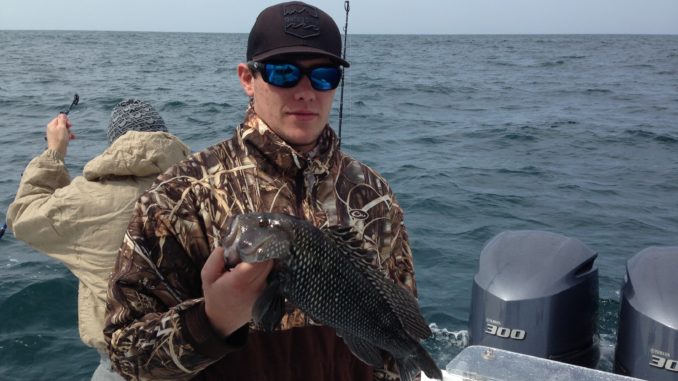
Keep your bait fresh and in front of black sea bass, and you’ll have a big nearshore day.
When the temperature plummets and the tourists head back inland for a long, cold winter, fish are still around to be caught in the waters off Brunswick County. It may take braving some chilly mornings or late afternoons, but the south-facing beaches are perfectly situated for sneaking out on a nice day to catch black sea bass.
While these smaller fish aren’t the best fighters in the ocean, they more than make up for their size and strength with abundance and value as table fare.
Black sea bass, centropristis striata, are actually not a member of the bass family at all, but the smallest member of the grouper family, which explains why they are such a sought-after meal. A legal-sized black sea bass weighs slightly more than a pound and is a common catch, while a 2-pounder is a real whopper — and larger fish do show up occasionally.
Black sea bass have no problem tolerating cooler water than other bottomfish, making them easy to target in the winter; in fact, this may be the best and easiest time of the year to catch black sea bass, as other fish found in similar areas during the summer (with the exception of sharks) have moved on to deeper and warmer water. In cooler weather, fish will stack up on just about any kind of structure of bottom variation. Find them, and you usually won’t have to move far to have a productive day.
Capt. Chris Dew runs nearly 200 charters a year out of the Ocean Isle Fishing Center, and some of his favorite trips are the offseason ones for black sea bass. His 17-year-old son, Aaron, often accompanies him as a mate when he’s not in school. Together, they have become masters of catching limits of these fish. Aaron Dew said he enjoys the cooler weather and the fact that he doesn’t have to run far to get to productive water; unlike many of the trips he runs during the summer.
Chris Dew rarely has to look deeper than 60 feet to find wintertime black sea bass. He prefers to fish ledges but said that any small bit of structure will do. The fish will aggregate on the smallest bit of different bottom, other than sand, and it’s just a question of getting them to bite. There are enough points within 12 to 15 miles of Shallotte Inlet that he can try several in a short time on a typical winter trip.
The beaches of Brunswick County face almost due south, so even a wind blowing out of the north, the ocean looks like a lake for the first eight miles out — even if the breeze is fairly stiff. If the wind picks up or the charter wants to stay in sight of land, there are still plenty of places closer to shore that offer good fishing, though the class of fish may possibly run smaller.
Chris Drew likes to fish 7-foot rods with conventional reels spooled with 30-pound monofilament. Aaron Dew rigs them with a sinker loop in the end of the line, then two dropper loops a few inches up from the sinker. Since there’s no swivel to tie in, the entire rig can be tied in a matter of seconds. He then loops on a bank sinker, which may vary in weight from 6 to 12 ounces, depending on the current, and loops a Daiichi Bleeding Bait circle hook onto each dropper loop. The hooks are baited with cut squid, and down the rigs go. It’s usually not long before rod tips start bouncing from bass attacking the squid.
Chris Dew likes to first drift over a spot, just to ensure that he is getting bites. After a few drifts over a ledge or structure, he will usually anchor over the best part of the drift. When he is anchored up, both he and his son can help anglers bait up, take fish off, and undo the tangles that always come with six anglers working off of the same boat. The action usually stays hot and heavy, even if the temperature is not.
If he wants to increase the size of the fish that customers are catching, Chris will often work in some live bait on his rigs. He likes to bring larger mud minnows in the livewell (in their own bucket, so they don’t escape into the overflow drain) and will add them to one of his rigs. The bigger bass have now qualms about swallowing a frisky mud minnow. This technique often adds to the biggest bass of the trip being caught. Live shrimp will work as well when available, but smaller bass have a tendency to pick them apart and kill them before they get inhaled. The mud minnows are simply a tougher, hardier bait and they hold on a circle hook much better as well.
Roger Gales no longer runs charter trips for a living, but that doesn’t mean that he doesn’t go black sea bass fishing. He fishes out of a 23-foot center console and loves to take his wife and 4-year-old daughter offshore to go and catch dinner. He especially enjoys black sea bass because it is a fishery he can involve young children, making it perfect for a family trip, with enough action to keep a child occupied and excited, compared to bored waiting for a king mackerel or grouper to bite.
To ensure plenty of action, Gales loves to chum, never leaving port without several bricks of frozen, ground anchovy chum, spare chum bags and several spare downrigger balls. Like Dew, he concentrates on ledges and rocks but prefers to anchor immediately. He will make several turns over a spot to see what it is holding, adjusting the gains on the depth finder. If fish show up on the screen this time of year, it’s a good bet many of them are the targeted bass.
Gales tries to set the anchor so his boat is directly above the ledge or rocks he’s targeting. If he’s over a ledge, he watches the depth display on the bottom machine to ensure it changes while the boat swings on the anchor rode. This lets him know he is directly on the spot. He said that in cooler water, fish won’t move as far to eat, so “hitting them on the head” with the sinker ensures that he will get bites.
When the boat is anchored, Gales immediately puts a frozen chum brick in a bag, clips it to the downrigger ball and drops it to the bottom, letting it wind down slowly so the line on the downrigger spool doesn’t tangle. When the ball hits bottom, the line goes slack, and he tightens the line and takes a single turn on the downrigger handle so that the bag is suspended, barely off of the bottom. He won’t put his baits down until he looks at his bottom unit and sees fish begin to congregate around the bag and biting it, which translates into the boom on the downrigger bouncing around.
Gales fishes similar tackle to Dew, but prefers slightly heavier line to lower the possibility of multiple lines tangling. He baits up with cut squid and drops it to the bottom, then tightens up to feel the bites. Sea bass are greedy and will usually swallow the squid, meaning a tight line or a little reeling is all that is needed to get the circle hook set in their jaws. With multiple hooks, Gales likes to lower the sinker back down when he’s got a fish hooked so he can load up the rig before reeling in. More often than not, a second bite comes quickly.
If the bite slows, Gales will crank the chum bag all the way to the surface, causing the bass to concentrate on the squid on the hooks, rather than getting a free meal of frozen anchovies. This, he said, is usually when he will catches his biggest fish of the trip.
Gales advises fishermen to change their baits often. The biggest black sea bass want fresh squid, not squid that has been washed out and lost its scent and color. Leaving your bait on may help keep your fingers cleaner, but it will result in catching smaller fish, many of them undersized throwbacks.
Gales said fishermen have one concern, and that’s the dog sharks that can be thick in cooler water, especially when he’s chumming. They are heavier than sea bass, and they have a tendency to roll up in the line and make a mess out of rigs, which then have to be re-tied. If you’re hooking too many sharks, the only thing to do is move, but it’s usually not a long run to the next productive spot.
Rube McMullan, whose family operates Ocean Isle Fishing Center, is another fan of catching sea bass, often taking his grandchildren on winter trips. After he gets them settled and catching fish, he has his own method for catching the biggest black sea bass in the school. He likes to drop jigs to the bottom on lighter spinning tackle; he said it’s a great way to maximize the size of what you are catching. It means only catching one fish per drop, but he said it’s the best way to catch keepers.
McMullan likes to use 30-pound braid on his spinning reels to ensure that the jigs drop straight down. Braid has a much- smaller diameter and is not affected as much by the current. It also has minimal stretch, so it is much easier for an angler to get a good hookset. If the current is fast, he simply casts forward and allows the jig to sink.
McMullan likes to use a single hook rather than a treble hook on his jigs. He uses a variety of jigs but says that the action he puts into the jig is much more important that the design. In the cooler water, a slower action is usually the way to go, but he will sometimes increase the action if the bass are being aggressive.
One thing anglers fishing with jigs need to keep in mind is that while circle hooks are required with natural bait when targeting grouper/snapper species, they are not required when fishing with artificial lures. It is perfectly legal to jig for bass with “J” hooks. However, if you want to add bait to your jig, then a circle hook is required again.
The vast majority of the time that you target winter sea bass, you are going to be successful in at least catching fish, regardless of the technique you use. However, the method you use to catch them can make a difference in the number of keepers you put on ice. Try different things until you figure out which one is producing the most big fish, especially if you want to put some of that pearly white meat in the frying pan that night.
With black sea bass congregated on nearshore marks for most of the winter, this is truly a great way to extend the fishing season, or to start it really early. It may be a bit chilly, but it’s a great time to spend time with the family without burning a lot of fuel. Just be sure to prepare for the elements and what the fish may want, and you will generally have a trip to remember.
DESTINATION INFORMATION
WHEN TO GO/HOW TO GET THERE — Black sea bass can be caught in nearshore waters off Brunswick County year-round, but fish school up on structure close to the beach during the winter, making it easier to get to them. US 17 is the prime route for accessing the area. Take NC 130 to Shallotte, Ocean Isle Beach or Holden Beach, and NC 211 to Southport or Oak Island. All areas have state-maintained, public boat ramps, and most inlets are in at least decent shape.
TACKLE/TECHNIQUES — Relatively stout tackle with conventional reels and two-hook bottom rigs are the ticket for most fishermen targeting black sea bass, although spinning tackle is good for jigging artificials off the bottom. Cut squid is the No. 1 bait, and some fishermen choose to attract black sea bass by putting a chum bag down close to the bottom.
FISHING INFO/CHARTERS — Capt. Chris Dew, Capt. Brant McMullan, Ocean Isle Fishing Center, Ocean Isle Beach, 910-575 3474, www.oifc.com; Capt. Cane Faircloth, Ollie Raja Charters, Ocean Isle Beach, 910-367-2998, www.holdenbeachfishingcharters.com. See also Guides and Charters in Classifieds.
ACCOMMODATIONS — Ocean Isle Inn, Ocean Isle Beach, 910-579 0750, www.oceanisleinn.com; Islander Inn, Ocean Isle Beach, 888-325 4753 www.islanderinn.com; Ocean Crest Motel, Oak Island, 910-278 3333, www.ocean-crest-motel.com.
MAPS — ProFinder Charts, 910-512 6700, www.prochipusa.com; Capt. Segull’s Nautical Charts, 888-473-4855, www.captainsegullcharts.com; Sealake Fishing; Guides, 800-411-0185, www.thegoodspots.com; Maps Unique, 910-458-9923, www.mapsunique.com; GMCO’s Chartbook of North Carolina, 888-420-6277, www.gmcomaps.com.

